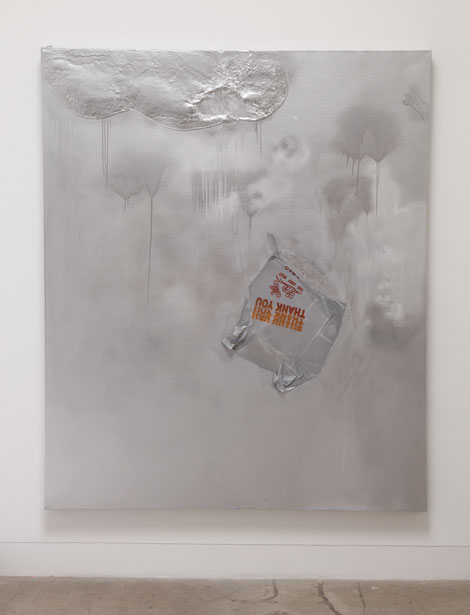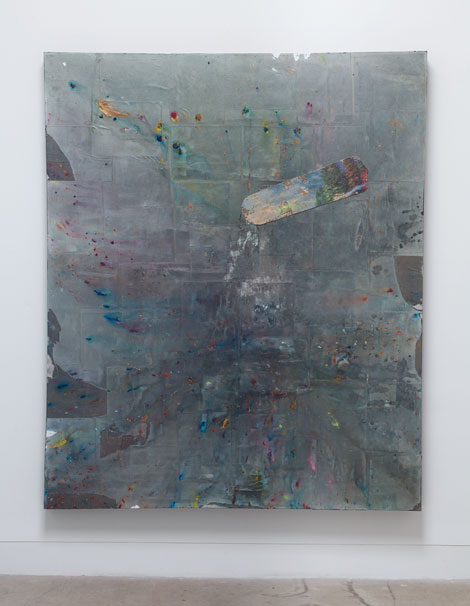Revealing a neglected and deliciously beautiful world from which we get only a handful of 72” x 60” snapshots—monochromatic yet stippled with smears, cracks and drips—Brenna Youngblood’s eight massive canvases, all mixed media, narrate a fall from grace.
Titles insinuate an unseen evil, suggesting leads like a film noir detective: Hidden City (2014), Women’s Health Pack (Drive Buy) (2013). A jigsaw puzzle fragment collaged onto the surface of Blade Runner: Painter of Light (2014) illustrates a Neo-Classical dome: Capitol Hill? The conspiracy runs deep and it’s clear we skim only the topmost layer, avoiding glances, keeping our heads low.
Bulging, spray-painted metallic canvases double billed as aluminum siding maintain the alley aesthetic in Youngblood’s crime beat-cum-sociological study. Use, wear and detritus become signs of discarded people. But who are we chasing? It’s unclear who or where the victims are, much less the perpetrators. Was the title of Women’s Health Pack (Drive Buy) lifted from a strip mall sign, its floral wallpaper unpasted from a sad state-funded clinic? The five points of rust-colored pigment in Hidden City now resemble a clenched handprint, the unpeeled strip of wallpaper in Women’s Health, a gun. Such stark insinuations of desperation and violence don’t demand anything of us; sitting as quietly and defiantly as evidence, their air of conspiracy never condenses, leaving us with a case gone cold.

Brenna Youngblood, Thank You, 2014. Mixed media on canvas, 72 x 60 in. Courtesy the artist and Honor Fraser Gallery, Los Angeles
An “Authorized Personnel” sign on Untitled (2013) is printed over backwards and upside down letters overlaying the originals to resemble a boxy Cyrillic script now unreadable: a mistranslation. The lost language across Youngblood’s “Project Series,” signs and symbols all deliriously unresolved, allow us only a taste of a long-simmering plot: injustices now rendered illegible, the proof slipping away.
Though Youngblood works her canvases with an almost loving detail, smoothing, sanding, and adorning them to masterfully direct our eye, they still dodge a full read. To try and have a conversation with her work is to be stymied by her staccato narratives, her camouflaged discourse, and her intricate and beautiful surfaces. Youngblood leaves tantalizing clues, but keeps us wading through the evidence.
In Blade Runner: Painter of Light (2014), splotches applied with delicate precision run down the canvas in streams as if power-washed away, another erasure from the urban renewal alluded to across Youngblood’s “Project Series.” On the same ground, a sprawling network of polished silvery patches appears to be chipped away, either by time or force of hand, revealing only industrial cinderblock gray.
This brief show plays like bullet points, tantalizing museum-goers to read the entire novel, to immerse themselves in this dejected post-apocalyptic and all-too-familiar world; like a spyglass to Skid Row down the street from Youngblood’s own downtown studio, or even further-flung reaches of our bombed-out urban galaxy. The cryptic assemblage of clues in Youngblood’s “Project Series” privileges ambiance over answers, the only takeaway being the emptiness in the pit of your stomach.



